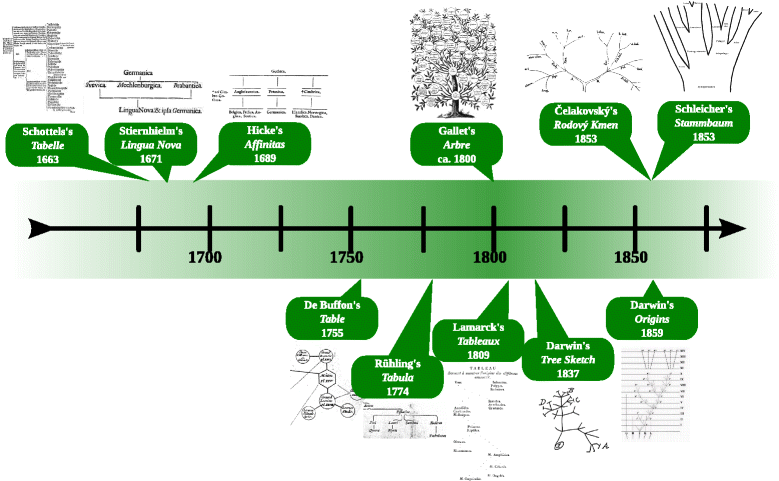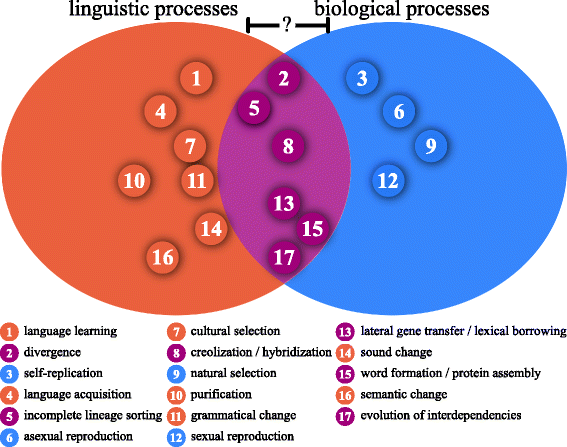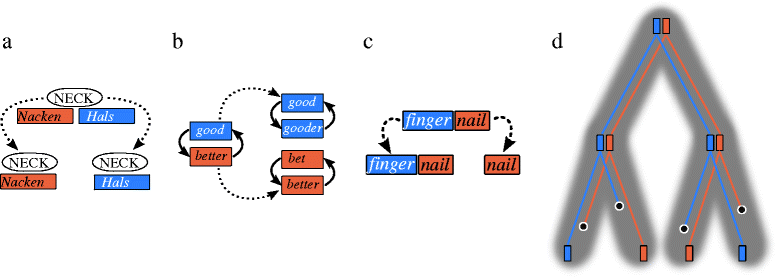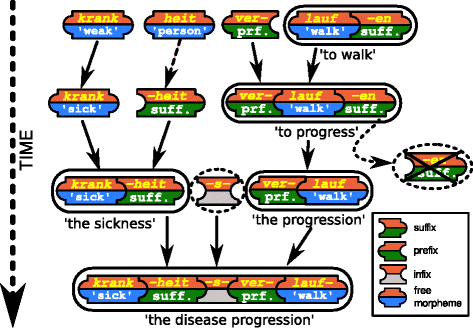Unity and disunity in evolutionary sciences: process-based analogies open common research avenues for biology and linguistics
- PMID: 27544206
- PMCID: PMC4992195
- DOI: 10.1186/s13062-016-0145-2
Unity and disunity in evolutionary sciences: process-based analogies open common research avenues for biology and linguistics
Abstract
Background: For a long time biologists and linguists have been noticing surprising similarities between the evolution of life forms and languages. Most of the proposed analogies have been rejected. Some, however, have persisted, and some even turned out to be fruitful, inspiring the transfer of methods and models between biology and linguistics up to today. Most proposed analogies were based on a comparison of the research objects rather than the processes that shaped their evolution. Focusing on process-based analogies, however, has the advantage of minimizing the risk of overstating similarities, while at the same time reflecting the common strategy to use processes to explain the evolution of complexity in both fields.
Results: We compared important evolutionary processes in biology and linguistics and identified processes specific to only one of the two disciplines as well as processes which seem to be analogous, potentially reflecting core evolutionary processes. These new process-based analogies support novel methodological transfer, expanding the application range of biological methods to the field of historical linguistics. We illustrate this by showing (i) how methods dealing with incomplete lineage sorting offer an introgression-free framework to analyze highly mosaic word distributions across languages; (ii) how sequence similarity networks can be used to identify composite and borrowed words across different languages; (iii) how research on partial homology can inspire new methods and models in both fields; and (iv) how constructive neutral evolution provides an original framework for analyzing convergent evolution in languages resulting from common descent (Sapir's drift).
Conclusions: Apart from new analogies between evolutionary processes, we also identified processes which are specific to either biology or linguistics. This shows that general evolution cannot be studied from within one discipline alone. In order to get a full picture of evolution, biologists and linguists need to complement their studies, trying to identify cross-disciplinary and discipline-specific evolutionary processes. The fact that we found many process-based analogies favoring transfer from biology to linguistics further shows that certain biological methods and models have a broader scope than previously recognized. This opens fruitful paths for collaboration between the two disciplines.
Reviewers: This article was reviewed by W. Ford Doolittle and Eugene V. Koonin.
Keywords: Constructive neutral evolution; Incomplete lineage sorting; Language evolution; Lateral transfer; Process-based analogies; Protein assembly; Similarity networks; Word formation.
Figures






References
-
- Popper KR. Three worlds. Tanner Lect Hum Values. 1978;:143–167. http://tannerlectures.utah.edu/_documents/a-to-z/p/popper80.pdf.
-
- Slingerland E, Collard M. Creating Consilience: Integrating the Sciences and the Humanities. Oxford: Oxford University Press; 2012.
-
- Kirby S. The role of I-language in diachronic adaptation. Z Sprachwiss. 2000;18(2):212–25.
-
- Schleicher A. Die ersten Spaltungen des indogermanischen Urvolkes [The first splits of the Indo-European prehistoric people] Allg Monatsschr Wiss Lit. 1853;3:786–7.
-
- Darwin C. On the Origin of Species by Means of Natural Selection. London: John Murray; 1859.
Publication types
MeSH terms
LinkOut - more resources
Full Text Sources
Other Literature Sources

